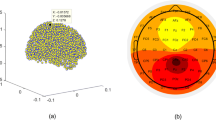Abstract
Electroencephalogram (EEG) has been a standard tool to monitor the status of the brain. For a quantification of EEG recordings, permutation entropy (PE) has been of interest due to simplicity and robustness to noise. A multiscale extension of PE, called multiscale PE (MPE), has been promising for describing the dynamical characteristics of EEG over multiple temporal scales. However, an imprecise estimation of MPE at large scales limits its application for analyzing of short EEG recordings. Here, with the aim of estimating MPE accurately, a modified MPE (MMPE) measure is presented. The proposed MMPE consists of two processes: (1) computation of PE values of all possible coarse-grained EEG time-series, (2) averaging of PE values at each scale. Through simulations with two synthetic signals, i.e., white and 1 / f noises, MMPE proves its capability over MPE in terms of accuracy. Experimental results using the actual EEG recordings indicate that MMPE is an improved quantifier in the sense that MMPE reduces variance of entropy estimation in comparison with MPE.









Similar content being viewed by others
References
Stam, C., Jelles, B., Achtereekte, H., Rombouts, S., Slaets, J., Keunen, R.: Investigation of EEG non-linearity in dementia and Parkinson’s disease. Electroencephalogr. Clin. Neurophysiol. 95(5), 309–317 (1995)
Jeong, J.: EEG dynamics in patients with Alzheimer’s disease. Clin. Neurophysiol. 115(7), 1490–1505 (2004)
Chen, D., Lu, D., Tian, M., He, S., Tian, J., Cai, C., Li, X.: Towards energy-efficient parallel analysis of neural signals. Clust. Comput. 16, 39–53 (2013)
Kandel, E.R., Schwartz, J.H., Jessell, T.M.: Principles of Neural Science. McGraw-Hill, New York (2000)
Monnerat, B.Z., Velasco, T.R., Assirati, J.A., Carlotti, C.G., Sakamoto, A.C.: On the prognostic value of ictal EEG patterns in temporal lobe epilepsy surgery: A cohort study. Seizure 22(4), 287–291 (2013)
Crepeau, A.Z., Rabinstein, A.A., Fugate, J.E., Mandrekar, J., Wijdicks, E.F., White, R.D., Britton, J.W.: Continuous EEG in therapeutic hypothermia after cardiac arrest prognostic and clinical value. Neurology 80(4), 339–344 (2013)
Park, R.C., Jung, H., Shin, D.-K., Kim, G.-J., Yoon, K.-H.: M2M-based smart health service for human UI/UX using motion recognition. Clust. Comput. 18, 221–232 (2015)
Do, L.-N., Yang, H.-J., Kim, S.-H., Lee, G.-S., Kim, S.-H.: A multi-voxel-activity-based feature selection method for human cognitive states classification by functional magnetic resonance imaging data. Clust. Comput. 18, 199–208 (2015)
Pincus, S.M.: Approximate entropy as a measure of system complexity. Proc. Natl Acad. Sci. 88(6), 2297–2301 (1991)
Richman, J.S., Moorman, J.R.: Physiological time-series analysis using approximate entropy and sample entropy. Am. J. Physiol. Heart Circ. Physiol. 278, H2039–H2049 (2000)
Chung, K., Oh, S.: Improvement of speech signal extraction method using detection filter of energy spectrum entropy. Clust. Comput. 18, 629–635 (2015)
Bandt, C., Pompe, B.: Permutation entropy: a natural complexity measure for time-series. Phys. Rev. Lett. 88(17), 174102 (2002)
Nicolaou, N., Georgiou, J.: The use of permutation entropy to characterize sleep electroencephalograms. Clin. EEG Neurosci. 42(1), 24–28 (2011)
Li, X., Ouyang, G., Richards, D.A.: Predictability analysis of absence seizures with permutation entropy. Epilepsy Res. 77(1), 70–74 (2007)
Costa, M., Goldberger, A.L., Peng, C.K.: Multiscale entropy analysis of complex physiologic time-series. Phys. Rev. Lett. 89, 068102 (2002)
Costa, M., Goldberger, A.L., Peng, C.K.: Multiscale entropy analysis of biological signals. Phys. Rev. Lett. 71, 021906 (2005)
Aziz, W., Arif, M.: Multiscale permutation entropy of physiological time-series. In: 9th International Multitopic Conference 2005 (IEEE INMIC 2005) Karachi (2005)
Ouyang, G., Li, J., Liu, X., Li, X.: Dynamic characteristics of absence EEG recordings with multiscale permutation entropy analysis. Epilepsy Res. 104(3), 246–252 (2013)
Shannon, C.E.: Communication theory of secrecy systems. AT&T Tech. J. 28(4), 656–715 (1949)
Amig, J.M., Zambrano, S., Sanjun, M.A.: True and false forbidden patterns in deterministic and random dynamics. Europhys. Lett. 79(5), 50001 (2007)
Ouyang, G., Dang, C., Richards, D.A., Li, X.: Ordinal pattern based similarity analysis for EEG recordings. Clin. Neurophysiol. 121(5), 694–703 (2010)
Andrzejak, R.G., Lehnertz, K., Mormann, F., Rieke, C., David, P., Elger, C.E.: Indications of nonlinear deterministic and finite-dimensional structures in time-series of brain electrical activity: dependence on recording region and brain state. Phys. Rev. E 64(6), 061907 (2001)
Bruzzo, A.A., Gesierich, B., Santi, M., Tassinari, C.A., Birbaumer, N., Rubboli, G.: Permutation entropy to detect vigilance changes and preictal states from scalp EEG in epileptic patients: a preliminary study. Neurol. Sci. 29(1), 3–9 (2008)
Olofsen, E., Sleigh, J., Dahan, A.: Permutation entropy of the electroencephalogram: a measure of anaesthetic drug effect. Br. J. Anaesth. 101(6), 810–821 (2008)
Acknowledgments
The present research has been conducted by the research Grant of Kwangwoon University in 2016.
Author information
Authors and Affiliations
Corresponding author
Rights and permissions
About this article
Cite this article
Choi, YS., Hyun, K. & Choi, JY. Assessing multiscale permutation entropy for short electroencephalogram recordings. Cluster Comput 19, 2305–2314 (2016). https://doi.org/10.1007/s10586-016-0648-8
Received:
Revised:
Accepted:
Published:
Issue Date:
DOI: https://doi.org/10.1007/s10586-016-0648-8




